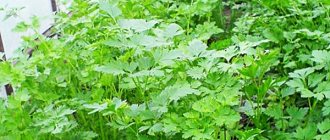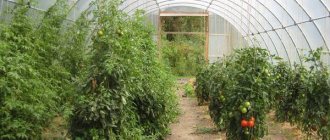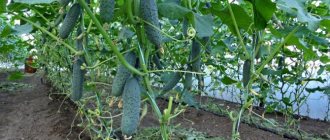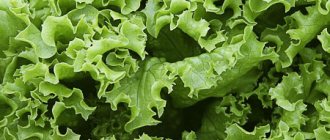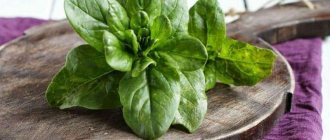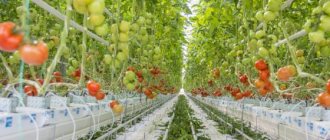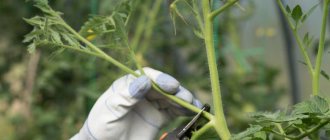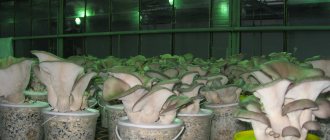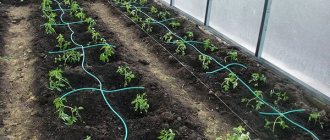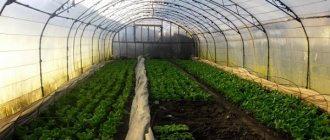Notice: Undefined variable: css_padding in /home/g/grigorig/prodachnika.com/public_html/wp-content/plugins/vote2x/vote.php on line 100 Notice: Undefined variable: css_opacity in /home/g/grigorig/prodachnika. com/public_html/wp-content/plugins/vote2x/vote.php on line 101 Notice: Undefined index: prodachnika_comvote2x3324 in /home/g/grigorig/prodachnika.com/public_html/wp-content/plugins/vote2x/vote.php on line 118 Tomatoes can be grown not only in summer, but also in winter. Of course, this process is not entirely simple and has its own nuances, such as maintaining temperature and light conditions, relative humidity, optimal for tomatoes. An experienced vegetable grower is not afraid of these difficulties, but a beginner may encounter certain problems.
An important point is the correct design of the greenhouse, which will include a heating, water supply, irrigation and lighting system. An important point is properly prepared soil. Only the combination of all these factors will help you get a good harvest. So, how to grow tomatoes in a greenhouse in winter?
Growing tomatoes in a greenhouse in winter
Having built a greenhouse device with a controlled microclimate, you need to use it wisely. Having invested money, there is no point in getting unprofitable products. For a high yield, you must strictly observe the growing conditions of the tomato plant:
- illumination indicators;
- humidity;
- temperature;
- air speed;
- soil nutritional value.
Features of preparing a greenhouse for winter growing tomatoes
When planning to grow tomatoes in a greenhouse in winter, you should determine the timing of fruiting and obtaining marketable fruit. This is necessary to understand when to sow tomato seeds for seedlings and how exactly to prepare the greenhouse itself.
Soil preparation
For tomatoes you need soil:
- clean from pathogens;
- nutritious;
- neutral or slightly alkaline;
- breathable
If the soil in the greenhouse is not changed from year to year, then loosening, natural materials should be used. For this purpose you can use:
- sawdust;
- straw chaff;
- fresh leaf compost.
Attention! If fresh materials are brought in, they are flavored with ammonium nitrate. Dissolve 2 tbsp in a bucket of water. spoons of fertilizer and water the straw until it is saturated wet.
In the second half of August, the greenhouse is sown with green manure. After 2 months, they are mowed and straw or sawdust flavored with ammonia is scattered over the surface. Next, everything is sprinkled with stove ash 2.5-3 kg per meter and humus 10-12 kg per meter of greenhouse area.
Ideally, if there is time, everything is dug up and left to “ripen” for 1 month.
With the onset of frost and snow, experienced vegetable growers practice covering the greenhouse soil with snow. This will provide the soil with moisture and normalize pathogenic microflora. As heating begins, the snow will melt, the earth will warm up and will be ready to accept tomato seedlings or seeds.
Light mode and ventilation
Each stage of development of a tomato plant requires its own lighting mode:
- emergence phase - 24 hours of light for 3-4 days, until 80% of the seeds sprout;
- seedling phase (until the moment of diving) - 16 hours for 10-12 days;
- after diving, shade for 2-3 days;
- until the seedlings are 30 days old - 16 hours of daylight;
- from one month of age to 60 days - 14 hours.
Note! Daylight should be continuous. It can be increased both in the morning and in the evening, or distributed between them.
Tomatoes also need ventilation during winter growing. She may be:
- manual, natural. Windows open in the side walls or ceiling;
- forced. To do this, use built-in fans powered by electricity;
- hydraulic. Works without electricity due to hydraulic drive;
The choice of ventilation system depends on the volume of the greenhouse.
Temperature
The best temperature for winter growing tomatoes in a greenhouse is between 20 and 25 ℃. if the readings exceed 33 ℃, then the pollen loses its viability. In this case, the pollen is said to be sterile. For the initial stages of growth and development, tomato needs the same temperature parameters.
If the temperature drops below 16℃, growth and development of the bush stops.
Features of preparing seedlings for planting in a greenhouse in winter
If it is necessary to plant seedlings in winter, then sowing is carried out so that by the time of planting the seedlings are 60-65 days old.
The stages of growing seedlings are as follows:
- seed germination;
- preparation of soil mixture;
- filling tubs or individual containers with soil;
- sowing tomato seeds;
- diving during individual cultivation;
- planting in a greenhouse at the fruiting site.
For winter planting of tomatoes in a greenhouse, there are no special requirements for seedlings. As for growing in a garden, it should be:
- healthy;
- stocky;
- have a height of 25-30 cm;
- have short internodes.
Features of caring for tomatoes in a greenhouse in winter
Planting tomatoes in a greenhouse before winter has its own characteristics. With short daylight hours, the main thing is illumination. You cannot produce a tomato crop without the optimal amount of light.
For successful fruiting, you must adhere to the following parameters:
- illumination;
- temperature;
- air exchange.
Watering tomatoes is carried out with warm water in the first half of the day. Fertilizers are often added to irrigation water for feeding.
The first feeding is carried out 10-12 days after planting the seedlings in the greenhouse. The second after 15-20 days, the subsequent ones after the same interval.
Suitable varieties for winter greenhouses
When looking for varieties for use in greenhouse conditions, preference should be given to high-yielding varieties that are resistant to temperature changes:
- The president.
- Hurricane;
- Geranium kiss;
- Siberian dwarf;
- Vasilevna;
- Evpator.
As a rule, several varieties are planted with different ripening periods. In this case, one variety will start the relay race, and the other will pick up fruiting.
Video: Tomatoes in a greenhouse in winter
After watching the video, you can clearly get an idea of growing tomatoes in a greenhouse in winter. Of course, not everything can be adopted and adapted to your own conditions. However, experience shows that even virtual communication with gardeners and greenhouse growers helps to find solutions to their problems.
Useful tips
Experienced vegetable growers on various forums share tips on caring for tomatoes.
These recommendations will help you grow a rich winter harvest of vegetables:
- Regularly remove damaged, dry leaves from plants and the area.
- Remove excess inflorescences: leave 5 on the first cluster, 6 on subsequent clusters. This will allow the fruits to appear evenly and have optimal sizes.
- Pollinate your tomatoes 3 times a week to get more yield.
- Pick fruits that are not brightly colored: they will ripen safely in a few days and will not waste the extra energy of the bushes.
- Pick the tomatoes carefully.
Secrets of flower pollination
There are no special secrets to pollinating flowers for indoor or greenhouse conditions. The tomato is a self-pollinating crop; it pollinates perfectly without human help. An exception can only be when the temperature rises above 32℃; this is not relevant for the room.
However, experienced gardeners have noticed that with regular “pulling” of stems with blossoming flowers, pollination and fruit set proceed better. It is enough to lightly tap the stem and then spray the flowers with water from a spray bottle.
Science has gone further and recommends spraying tomato bushes during budding with a 0.1% boric acid solution. To do this, it is enough to use a miniature sprayer to treat the tips of the shoots and buds to a state of light moisture. Such treatments should be carried out once every 10-12 days. There is no point in re-processing the same buds.
Bush type and size
Among the varieties of tomatoes, there are three types of bushes, namely:
- Determinant. These are bushes that grow only to a certain size, after which their shoots and shoots must be pruned. They are, as a rule, less demanding and produce a moderate harvest;
- Indeterminate. Such bushes can grow constantly and do not need constant pruning of shoots and shoots, but they produce a bountiful harvest. They are also particularly whimsical; as a rule, they are grown only in greenhouses;
- Semi-determinant. This type of bush is something between the previous two. The bush does not always stop growing, and the stepsons do not need to be shortened constantly, but still, it has to be done periodically.
The sizes of bushes are small, medium and large.
Tomato diseases in winter
In indoor and greenhouse conditions, tomatoes can also be susceptible to diseases. During the seedling period, black leg is dangerous. To avoid this, you need to maintain optimal microclimate and watering conditions.
During the fruiting period, a tomato may be affected by:
- late blight;
- Alternaria blight;
- cladosporiosis;
- anthracnose;
- powdery mildew.
Attention! By following the rules of agricultural technology, damage can be avoided.
Modern plant protection products are quite effective. Using them for preventive purposes can prevent the emergence and spread of diseases.
The following have proven themselves to be the most effective:
- Baktofit;
- Quadris;
- Trichodermin;
- Topaz;
- Byleton;
- Pseudobacterin-2;
- Fitosprin -M.
A careful examination of tomato bushes and timely diagnosis of the disease will help to quickly identify and treat the bushes. Pay attention to the instructions for the drug and especially the waiting period during fruiting.
Positive qualities of varieties
It should be noted here that determinate varieties of tomatoes are earlier ripening than indeterminate varieties. All varieties are divided into early, early ripening and ultra-ripe. It is quite obvious that the latter ripen earlier than the others.
There are large-fruited ones, among which we can highlight the famous “Siberian giant”, which is grown, as a rule, to the east of the Urals. Medium-fruited fruits can be grown for salads and canning. Well, among the small-fruited ones, the ones that distinguished themselves are, of course, “Cherry”.
As a rule, hybrids specially bred for this purpose have good storage or keeping quality. Unfortunately, they can rarely be called tasty. Although the taste of a product is relative, because the perception depends on the receptors of the person who tastes it.
As we noted above, taste is a relative concept. Some people like soft and juicy tomatoes, while others like small and hard ones. Some varieties are ideal for twisting, others for juices, and others are simply created for salads and various delicacies.
It can be separately noted that the sweetest and “tastiest” varieties, by general standards, are distinguished by a very long ripening period and are especially whimsical.
Feeding for proper development
If seedlings are grown in universal soil, then they do not require fertilizing. After planting in the place of fruiting, after 12-15 days the plant needs to be fed with a solution of ammonium nitrate 1 tbsp. spoon in a bucket of water or superphosphate in the same concentration.
The second and subsequent feedings can be carried out after 15-20 days. The last feeding is carried out 2-3 weeks before the end of fruiting.
Fertilizing that alternates organic and mineral fertilizers gives very good results.
For organic feeding you can use:
- faeces from cattle, pigs and horses. Solutions are prepared in 1 kg per bucket of water;
- chicken droppings. The concentration is maintained at 0.5 kg per bucket of water;
- compost infusion 2-3 kg per bucket of water with standing for 3-4 days.
Note! Experienced vegetable growers have noticed that fertilizing with less concentrated solutions, but more often, gives higher yields.
There's no point in trying too hard. Overfeeding is just as dangerous as underfeeding. It will immediately affect your appearance. Eg:
- yellow leaf. It can be due to both nitrogen and calcium deficiency. However, in the first case the process begins from the lower sheet plates, and in the second from the upper ones;
- a wrinkled leaf indicates overfeeding with calcium and potassium is not absorbed;
- a thick, dense, hard leaf indicates sulfur deficiency;
- A yellow outline along the edge of the leaf indicates a magnesium deficiency.
Soils are rich in nutrients. If in doubt, it is better not to use fertilizer.
Transplantation to a permanent place
Transplantation into a greenhouse is carried out when the plants develop 6-7 true leaves.
A few days before transplanting, the seedlings are transferred to the greenhouse so that they get used to the new microconditions.- The air temperature in the greenhouse is raised to 230-240.
- A week before transplantation, seedlings are sprayed with a 5% copper sulfate solution to prevent fungal diseases.
- Two days before transplanting, the seedlings are watered abundantly.
- The planting pattern is two-line tape. Holes are made in the ground at a distance of about half a meter from each other. If the variety in the description is described as powerful, the distance between holes is 60-70 cm, the distance between rows is 60-90 cm.
- The wells are treated with a solution of potassium permanganate (2 g/l).
- At least 0.5 liters of water (not cold!) is poured into each well.
- Turning it over, carefully remove the seedling along with the lump of earth.
- Move the seedling into the hole, bury it along the cotyledon, and carefully compact it.
What difficulties may arise
When planting tomatoes before winter, you may encounter a number of difficulties. The following is relevant for the greenhouse:
- inability to regulate temperature and humidity. To monitor these parameters, you should use thermometers and hygrometers. However, they cannot show information in the entire greenhouse and some of the plants may suffer;
- illumination. In winter, the greenhouse should be equipped with backlight lamps. Otherwise, the plants will stretch;
- diseases. If the soil and the entire greenhouse structure are not treated after use last season and plant diseases are observed, then there is a high probability of recurrence. Before use, you should use sulfur bombs, disinfection and disinsection means, and change the soil;
- fragility of the structure. Heavy snow often reduces the work of a vegetable grower to zero. Constantly removing snow from the roof of a greenhouse is a mandatory procedure. You should not allow roof failures - this can lead to the loss of the entire crop.
The living room is not a perfect place for fruiting tomatoes. Difficulties in growing indoor varieties may be the following:
- yellowing and falling of leaves and ovaries. The cause may be dry air, low light, high temperature or dry soil. By eliminating the causes, the tomato will quickly recover;
- the plant is booming. The stem becomes powerful and thick. The leaf is bright green and huge. Stepchildren grow quickly and are “fat”. At the same time, the flowers are small and the brush is very weak. Everything points to nitrogen overfeeding. In this case, you need to increase the temperature, do not water the plant for 6-7 days, and pollinate the flowers manually with a brush. Next, carry out abundant watering with clean water and drain it into the pan;
- the plant “withers” for no apparent reason. Pay attention to drafts (windows, windows) and possible gas contamination. Perfumes are not tomatoes' best friend. Sometimes close proximity does not allow the plant to develop evenly and begin to bear fruit. The same can be said about the neighborhood with indoor plants.
Each apartment and room is its own little world. You can’t foresee all the difficulties in advance, but you can monitor the condition of the tomatoes. They themselves are quite capable of suggesting solutions to problems.
Resistance to infections and adverse conditions
This indicator is associated with the whimsicality of the fruits, their immunity, as well as how much they need care and attention. We will not dwell on this point for long, but will only note that all greenhouse varieties are not particularly resistant, and therefore require careful and constant care.
To summarize, it can be noted that there are a lot of varieties of tomatoes. That is why it is difficult to say which one is better and which one is worse. It is important that every summer resident who is planning to grow tomatoes, before planting them, understands what exactly he expects from his fruits.
yavteplice.ru
Basic recommendations for growing tomatoes in winter
When thinking about growing tomatoes in winter on a balcony, greenhouse or room, make a plan. It must spell out each point of agricultural technology and possible ways to comply with it. If at least one point cannot be accomplished, put the idea aside for a while. It will be a pity if the plant dies. As soon as you can fully satisfy the needs of the tomato during growth and fruiting, you can begin sowing.
When growing in a greenhouse or room, sometimes there is a need to accelerate the formation and development of fruits. To do this, use the technique of tearing the roots. The whole plant is pulled up, as if pulled by the trunk from the tub. At this time, the small roots are slightly undermined. Afterwards, the bush is watered abundantly and lightly hilled. The plant rapidly begins to grow, forms an ovary and produces fruits.
Attention! The “acceleration” procedure can be performed on a bush only once.
To control the microclimate, get measuring instruments. It is impossible to determine the ambient temperature by eye. It is even more difficult to determine humidity. Take care of additional lighting lamps and heating devices in case of unforeseen circumstances in winter.
Air temperature
Each stage of growing tomato seedlings is accompanied by separate requirements, including changes in air temperature. Read about the features of the Hercules bow in this article.
The maximum temperature that tomatoes support is 40 degrees. Although tomatoes love heat, they practically cannot withstand elevated temperatures, which can lead to plant disease and death.
We invite you to familiarize yourself with Strawberry Elsanta variety description
Optimal conditions
It is believed that the optimal temperature range is between 12-18 degrees at night and 23-27 during the day, but these data are relevant for already grown tomatoes. After emergence, it is necessary to reduce the temperature to 16-18 degrees during the day and 11-15 at night. This scheme avoids excessive stretching of seedlings and improves germination of the root system.
After picking, experts recommend adhering to a slightly different regime - 17-18 at night, 20-22 during the day. The duration of growing seedlings according to this scheme is up to 30 days after germination. It all depends on the appearance of the second true leaf
It is very important not to allow the temperature to rise, as this can lead to serious stretching of the seedlings and fragility of the sprouts
How to regulate
Adjusting the temperature depends on the equipment used for heating or cooling the air. If the seedlings are additionally heated using any heating devices, then it is imperative to keep the sprouts in conditions where the recommended temperature does not exceed the norm. Most often, gardeners grow seedlings on windows with a battery at the bottom.
If because of this it is not possible to maintain the temperature regime, then the optimal solution would be to raise the seedlings to a level higher from it. If the room is too hot, you can use an air conditioner or fan. This technique must be used very carefully, since hypothermia can lead to significantly greater negative consequences than undercooling by a couple of degrees.
Seedling
Start growing tomato seedlings in the fall, and the timing may vary in different regions. In the northern regions, seeds are sown in November, in the southern regions they begin to sow earlier - at the end of September and in October.
In a maximum of two months, the seedlings will be ready for transplanting to a permanent location. If this time falls in December (with early sowing), then lighting will require large amounts of electricity.
For planting seeds, special multi-cell cassettes are used. The temperature in the greenhouse is maintained at +24 °C. After 5–7 days, shoots will appear, and then it will be necessary to apply lighting and reduce the daytime temperature to +19°, and the night temperature to +16°. In winter, the first 7 days of illumination should be around the clock, but gradually it can be reduced to 12 hours a day.
IT IS IMPORTANT TO KNOW! Electricity tariffs are rising every day. To start saving on electricity today, learn about a legal way to reduce your utility costs by up to 50%! Read more…
When the first true leaves begin to form, picking is done. Without it, it will not be possible to grow full-fledged seedlings. After 20 days, with slow growth, the first fertilizing is carried out with an aqueous solution of mineral fertilizers. Repeated feeding is done when 4–5 leaves appear. The concentration of fertilizers can be increased. After each feeding, water the plants with warm water.
When 6-7 leaves appear, you can transplant the tomatoes into the beds. The temperature in the greenhouse during this period is increased to +23 °C... +24 °C.
Soil selection
Particular attention should be paid to the substrate for growing tomatoes on the windowsill. It should be loose, nutritious and neutral acidity
The easiest way is to go to the same store where you bought the seeds and purchase ready-made special soil mixtures for tomato seedlings. This will be especially true for winter sowing; besides, store-bought soil already contains all the necessary nutrients, and there is no need to add additional components.
If you have the desire and opportunity, you can prepare the soil for growing tomatoes on the windowsill yourself by choosing one of the proposed mixture options, namely:
- 1 share of sand and 2 shares of garden soil;
- humus, peat and turf soil in equal parts;
- 1 share of vermiculite, as well as 4 shares of turf soil and compost.
Harvesting
To grow a full-fledged harvest on the windowsill, it is important to collect the fruits on time. In winter, remove saturated tomatoes that have begun to turn slightly pink.
They are placed for ripening on a window or in a dark box. The process will go through to the end, and the bush will “throw” all the released useful substances into growing the fruits remaining on the branches.
Knowing how to grow tomatoes at home on a windowsill or balcony, you can pamper your loved ones with “delicious plantings” not only in summer, but also in winter. This will especially please children, who will examine each plant with the greatest curiosity and will certainly taste the small tasty “tomatoes”.
Convenient sowing we sow the garden bed
The previous method has one drawback - the seedlings obtained from such planting grow too densely and are not very convenient to work with. Therefore, many gardeners prefer to plant seeds in the traditional way. Tomatoes do not like deep planting, so there should be no more than two centimeters of soil above the seeds. For the winter, you should sow thicker than usual, since the germination percentage is often lower than with standard planting. Do not spare the seeds - it is better to pull out weak plants, leaving only the strongest shoots. To protect planting material from frost, a layer of mulch should be laid over the bed.
A layer of mulch to protect planting material from frost
Seeds should never be soaked before planting - this procedure is acceptable in the spring, but in this case it would be completely inappropriate. Melt water and frost will work no worse than potassium permanganate and other newer preparations for seeds. There will be enough moisture in the soil for them to start growing with the first rays of the sun.
Tomato seeds for planting in winter
Choosing the time of planting before winter is the most difficult moment. Seeds should not be sown in warm weather to avoid causing them to germinate prematurely. For the same reason, thaws are also dangerous. There is only one way out of this uncertain situation - prepare the bed in advance (loosen the soil, spread compost), mulch, and as soon as the soil freezes a little, sow the seeds and cover the bed with mulch. Then, even during a thaw, the cold will remain under the mulch layer for a long time, keeping the seeds from germinating.
Select your seeds carefully
To grow good tomato crops, you need to start by selecting resistant varieties. Vegetable growers have recently increasingly given preference to domestic varieties, which are created taking into account our soil, climatic and phytosanitary conditions. For example, scientists from the All-Russian Research Institute of Irrigated Vegetable and Melon Growing (Astrakhan) recommend the following varieties:
- Ranovik
- Chizhik
- Record holder
- Forward
- Royal
- Gigantella
- Cleopatra
- New Prince
- Orange avyuri
- Astrakhansky 5/25
These varieties are distinguished (of course, to varying degrees) by resistance to blossom end rot, cracking, dry growing conditions, viral and fungal diseases. Many gardeners give preference to foreign varieties - this is not entirely correct. Scientists emphasize that foreign-bred varieties are inferior to domestic ones in terms of taste, resistance to many diseases, and yield.
You can grow tomatoes from your own seeds
For those who grow tomatoes from their own seeds, scientists recommend:
Firstly, harvest them only from ripe fruits collected from healthy plants.
Secondly, be sure to ferment the seeds in the pulp for 2-3 days.
For sowing, it is better to use not fresh, but 2-3-year-old seeds, which are freed from pathogens during storage. Pre-sowing treatment in solutions of biological preparations: phytosporin-M also helps to reduce seed contamination. Alirin-B, gamair. The same preparations are used to treat plants during the growing season.
Educational video on how to prepare and sow tomato seeds:
Business registration
Any type of activity is subject to mandatory registration. Therefore, before you start industrially growing vegetables, you should legally register your activities.
Video on the topic
Select the appropriate substantive form of activity: individual entrepreneur or LLC. If you own a plot of land, it is easier to register as an individual entrepreneur. But when you plan to open a large vegetable farm, you should register as a legal entity.
If you are going to additionally store vegetables, then you need to obtain the appropriate permits from the sanitary-epidemiological and fire services.
